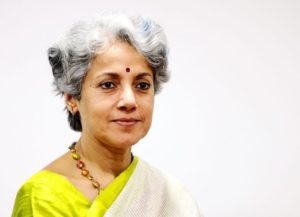Dr Soumya Swaminathan – First Indian – WHO
 Dr Soumya Swaminathan, Director-General (DG) of the Indian Council of Medical Research (ICMR) and secretary, department of health research, is the first Indian to be appointed to the second highest position at the World Health Organization (WHO) in Geneva. Known in particular for her work on tuberculosis, Swaminathan will be taking over her new role as deputy DG, Programmes, at WHO within a few weeks. She spoke to Rohit E David on the challenges facing the world’s apex health body, the problems in Indian healthcare and India’s role in the global health architecture:
Dr Soumya Swaminathan, Director-General (DG) of the Indian Council of Medical Research (ICMR) and secretary, department of health research, is the first Indian to be appointed to the second highest position at the World Health Organization (WHO) in Geneva. Known in particular for her work on tuberculosis, Swaminathan will be taking over her new role as deputy DG, Programmes, at WHO within a few weeks. She spoke to Rohit E David on the challenges facing the world’s apex health body, the problems in Indian healthcare and India’s role in the global health architecture:
What are some of the challenges in front of you as WHO deputy DG?
First of all, the responsibility is huge. The work which WHO’s DG has given me as deputy DG, Programmes, means working across divisions of WHO. My job will be to achieve the goals he has laid out. I see it as a wonderful opportunity. I think I will be able to bring people together, synergise them and focus on some high impact programmes.
You are the daughter of MS Swaminathan, the father of India’s Green Revolution. Will you also usher in a revolution at WHO?
WHO is a huge organisation and I will be playing an important role no doubt as the number two. I would do my best in that post. The position will give me an opportunity to do a lot of good for global health.
India has a big role in global healthcare. How can India help in creating a good healthcare facility for the world?
India is already playing a huge part in the global health club by way of producing drugs and vaccines. I think over 50-60% of generic drugs and vaccines across the world are now supplied from India. That’s a huge contribution as well as a responsibility.
Now, we can also deliver in other areas in healthcare, especially in innovation of affordable and cost effective technology – whether that’s diagnostic or devices. We can serve Indian healthcare but also the world. I think India has a huge potential to come up with vaccines much before anyone else in the world. Sometimes we do need partnerships. The rotavirus vaccine was in partnership with many different agencies and groups.
What ails India’s public healthcare?
We have a wide spectrum of public healthcare facilities. This extends from some of the southern states which have done extremely well to a large number of emerging states which have a lot of catching up to do. I think the basic issue has been lack of prioritisation. Now there is widespread recognition that health has to be very high on the priority list of any government – central or state. The situation is changing now.
How can WHO help India eliminate tuberculosis?
In fact, India can help the world eliminate tuberculosis. Most of the world’s TB patients are from India. We have got everything it takes to develop new tools, strategies to control and eliminate TB. We have got the basic research and development (R&D), patients whom we can do clinical trials on, funding and political commitment.
Nobody believed that India could eradicate polio, but we did it. TB equally looks like a big challenge. But everything is being laid out for eliminating TB, if that plan can be implemented. I see no difficulty. WHO can bring countries together to provide technical assistance wherever needed.
You have advocated universal health coverage. Can you expound a bit more on what you mean by that?
Universal health coverage is the biggest goal of WHO. To take a country like India, and many others which are probably in a worse situation, and provide health coverage to them is the aim. This will mean starting from physical infrastructure in remote areas, human resources both in remote and urban areas, health financing and ensuring health insurance. The goal is to provide universal healthcare to everyone in the world.
WHO has 60% employees who are women in its wings. Do you feel that gender bias has been broken in the world’s apex health organisation?
It is a very strong message. Women in leadership positions can make a difference in global health. Let’s see. It is a very exciting beginning. A couple of years in the job will show.
Ref : Times of India






Leave a Reply